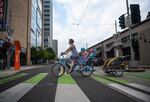It’s evening in Portland’s South Waterfront District, and Annie Rudwick is getting her kids loaded for the trip home from work and daycare.
Many parents would see this as a job for something like a minivan. But Rudwick is helping her daughters – aged 1, 3 and 5 – onto the back of her electric-assist cargo bike

Annie Rudwick bikes to work with her daughters.
Cheyenne Thorpe / OPB
The e-boost gives her the power to easily carry a hundred pounds of kid. And because of Portland’s rush-hour congestion, she says her four mile trip each way is often quicker by bike.
“I didn’t want to have to bike and take a shower. I wanted something I could just commute in and get to work,” said Rudwick, the associate dean for finance and administration at Oregon Health & Science University’s School of Dentistry.
“The electric bike allows me to not have to exercise as much,” she added. “It really is just a mode of transportation.”
Ruwick’s 12-foot-long bike-and-trailer combination is not the only vehicle that turns heads in the bike lanes.
She’s part of a new trend that transportation experts are calling micromobility. It’s the idea that new technology – including smartphones and more efficient batteries – is sparking a big jump in small, nimble vehicles suited for increasingly crowded city streets.
“We’re seeing a lot more users in bike lanes – bicycles, electric scooters, electric bikes. I see people on kind of skateboard sort of conveyances,” said Jillian Detweiler, executive director of The Street Trust, formerly known as the Bicycle Transportation Alliance.
Most notable are those rental scooters that have been sprouting up in cities around the world. About 2,600 are now on the streets of Portland.

Bicycles are just one of many transportation vehicles in Portland's bike lanes. An increase of micromobility has lead to an increase in electric scooters and electric bikes.
Cheyenne Thorpe / OPB
“I think people are just looking for different ways to get around,” said Chris Warner, director of the Portland Bureau of Transportation. He added that the popularity of the scooters show that riders are finding them a fun and affordable way to make short trips.
Those scooters themselves are evolving. Since June, two scooter companies have offered vehicles with seats and larger wheels. Warner said he tried one out and liked it.
“You know, I found the seated one a little steadier,” he said, noting that it could attract riders who find the standing scooters intimidating.
A recent report from Deloitte, the international consulting firm, said the rapid growth of the scooter industry – at a pace faster than the early years of ride-hailing companies like Uber – has boosted business interest in micromobility.
These vehicles “have the potential to better connect people with public transit, reduce reliance on private cars, and make the most of existing space by ‘right-sizing’ the vehicle, all while reducing greenhouse gas emissions,” the Deloitte report said.
Nobody’s quite sure how far all this will go. For example, China is pumping out hundreds of thousands of low-speed electric cars that are typically about the size of golf carts. The Street Trust’s Detweiler said something like that could someday end up in Portland.
“What we want to promote is using the right mode for the trip that you’re trying to take,” she said.
Her trip to work, Detweiler added, is something she could readily make by bicycle. But maybe the “trip to the grocery store where I’m trying to get the 20% discount on a case of wine could be made a little two-seater electric car with a small cargo space in back.”
Sam Schwartz, a former New York City transportation commissioner, has long argued for reducing the use of single-occupancy autos in dense cities. In his new book, “No One at the Wheel: Driverless Cars and the Road of the Future,” Schwartz argues that the advent of autonomous vehicles could be either a boon or a bane for micromobility.
“Something’s got to give,” Schwartz said in a recent telephone interview. “You can’t have so many modes that move at different speeds.”
Schwartz said he wants to see self-driving vehicles regulated, in order to spur the use of transit and low-speed autonomous vehicles in cities. What he doesn’t want to see are large, single-occupant autonomous vehicles that wind up pushing other users off the street.
That’s something that could happen, he said, predicting that the tech-heavy automakers of the future “will be the most powerful industry on earth.”
Of course, there’s plenty to argue about besides the future of robot cars.

Portland's electric bikes and scooters are increasing in popularity around the city.
Cheyenne Thorpe / OPB
Today, the proliferation of scooters is riling plenty of people who complain that riders are too apt to use them on sidewalks – or to park them in ways that interfere with pedestrians or cars. Cyclists using their own energy to pedal are also having to contend with a lot of vehicles in bike lanes that move in different ways and speeds.
Joe Kurmaskie, a longtime writer on bikes in Portland and executive director of the Washington County Bicycle Transportation Coalition, started to say that the increasing diversity in the bike lanes has its good and bad points.
“Well, bad is maybe not the right word,” he quickly added. “[It’s] more learning to share the limited space we’re given as cyclists.”
Warner, the Portland transportation director, said Portland still has a lot of capacity in its bike lanes and is well-positioned to be on the front lines of micromobility.
The city has nearly 400 miles of bike routes and may expand its bike-share network next year to include electric bikes. That could attract potential riders who want the ease of e-bikes but don’t want to shell out the $1,500 to $4,000 cost of one.
“We’re really open and hoping to encourage innovation and finding ways to get people around safely and sustainably,” Warner said.
Rudwick, who uses the electronic-assist cargo bike, said her daily commute gives her a glimpse of a city built around micromobility.
“For me,” she said, “the system is so great.”
Almost her entire ride is either in bike lanes or off-street paths. She gets free valet parking at the base of the tram up to OHSU, which means she doesn’t even have to lock her bike.
In addition, OHSU gives Rudwick a $1.50-a-day subsidy for cycling to work. More importantly, she avoids car parking fees that run at least $13 a day.

Annie Rudwick adjusts her daughter's helmet as they prepare for a bike ride.
Cheyenne Thorpe / OPB
“You can buy a lot of e-bike with the cost savings there,” said her husband, Allan Rudwick, who has long been avid about the potential of electric bikes.
“I’m really excited to see where this goes,” he said of the emerging micromobility revolution.
Annie Rudwick said she now finds that the days when she has to drive to work are the most hassle. But she conceded that her daughters sometime complain about cycling in the rain.